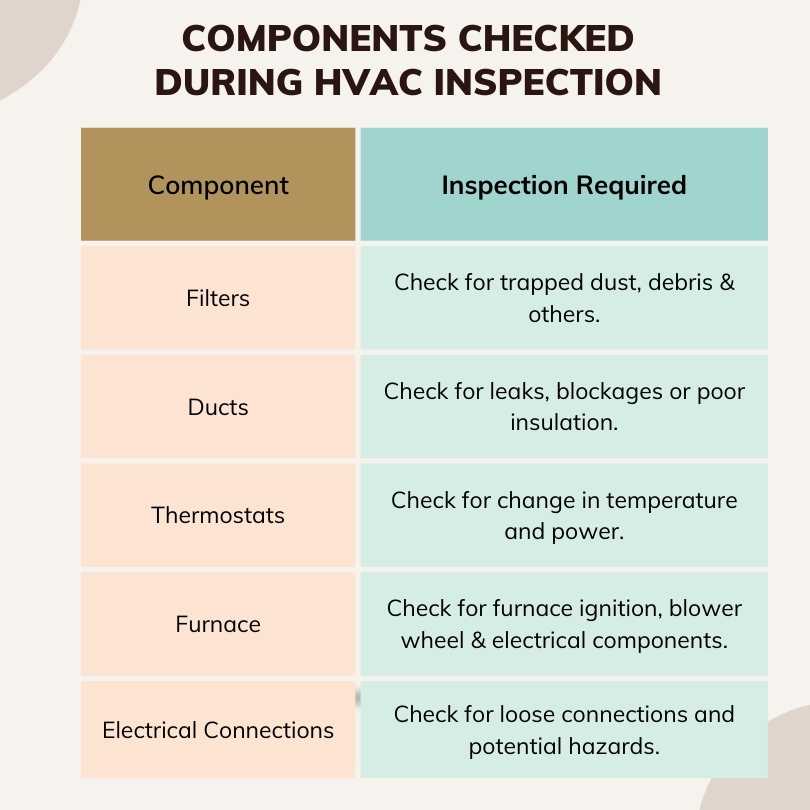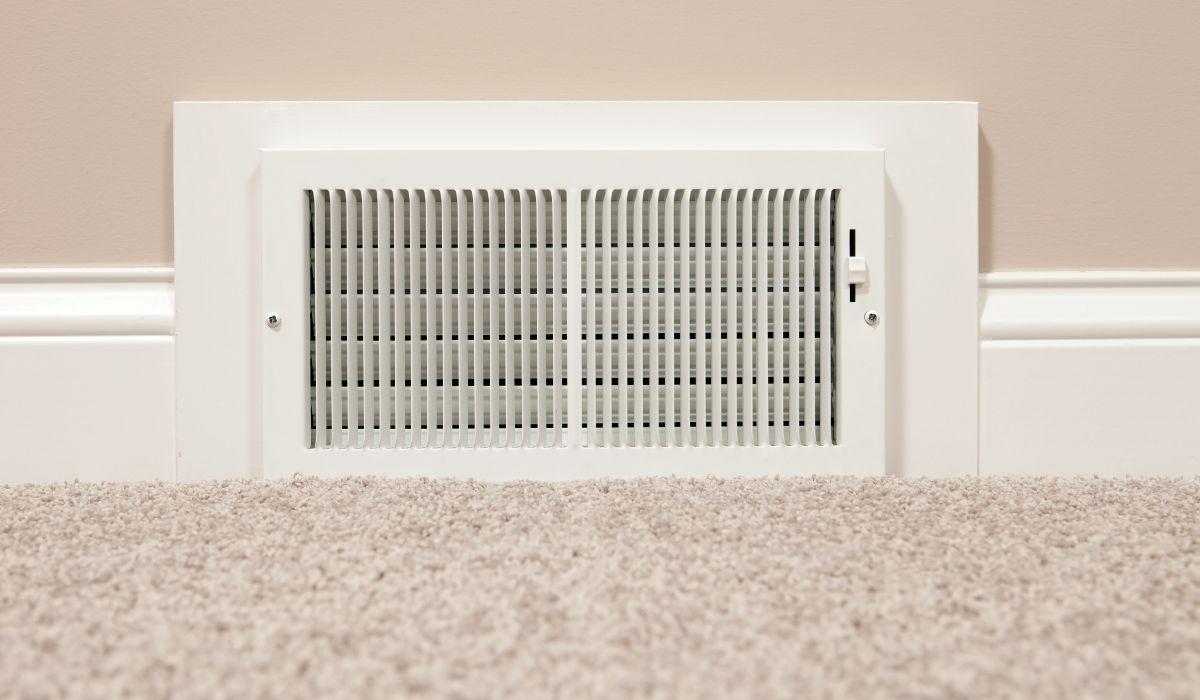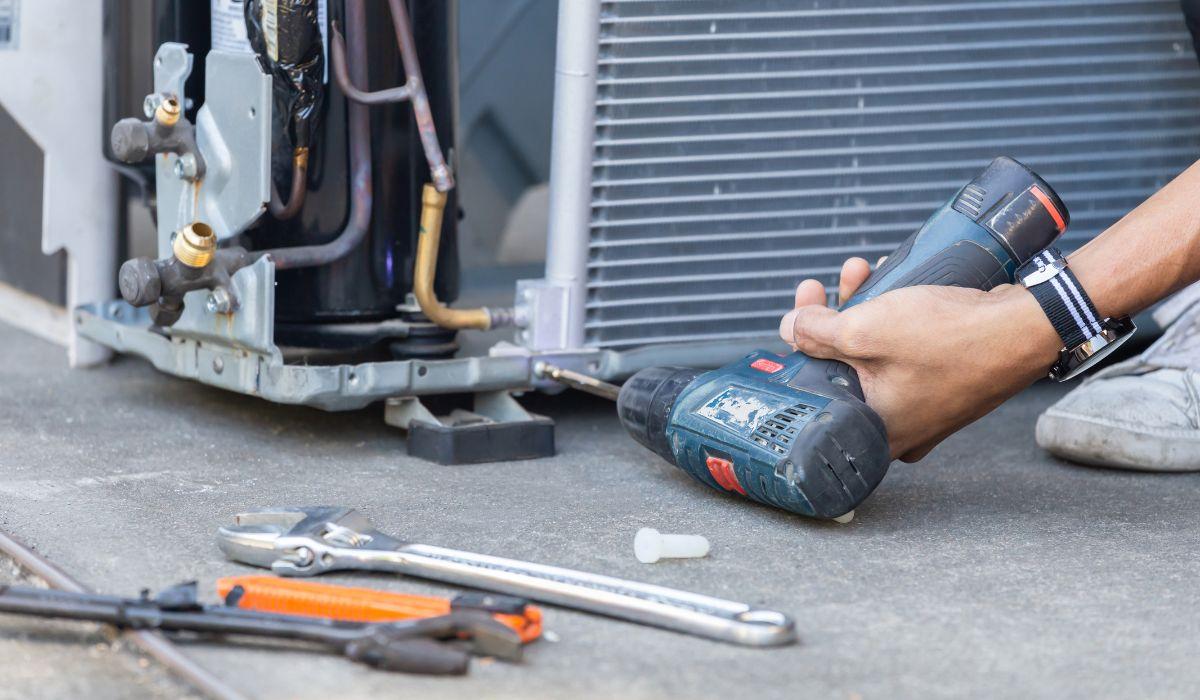In the domain of home comfort, understanding the pivotal role of HVAC inspection is principal. Regular HVAC checks, a cornerstone of routine home maintenance, are instrumental in preserving optimal heating, ventilation, and air conditioning (HVAC) system performance.
These inspections form a protective shield around your home's energy efficiency, ensuring it operates at its peak.
Beyond energy concerns, embracing routine HVAC inspections contributes significantly to indoor comfort. Picture a scenario where your home maintains the perfect temperature year-round, creating an oasis of coziness.
In this article, we look into the workings of HVAC inspections, explaining their significance for homeowners.

In the scope of home comfort, HVAC inspection, including air conditioning checks, is crucial for keeping things running smoothly.
We'll break down the basics and the components of these air conditioning inspections, ensuring your home stays comfortable and energy-efficient.
HVAC home inspection is a meticulous process designed to assess and maintain the optimal performance of heating, ventilation, and air conditioning (HVAC) systems within residential spaces.
This critical examination serves multiple purposes, ranging from identifying potential issues to ensuring the safety of occupants and extending the overall lifespan of the HVAC system.
HVAC inspectors thoroughly examine the entire system, aiming to pinpoint any potential issues that might compromise its functionality.
This includes scrutinizing components such as the furnace, air conditioner, ductwork, and thermostat. By detecting and addressing problems early on, homeowners can prevent costly repairs and maintain uninterrupted system operation.
One primary objective of HVAC system inspection is to guarantee the safety of the household.
Inspectors assess gas connections, examine the heat exchanger for potential cracks, and ensure proper ventilation.
This focus on safety is paramount, as it protects the occupants from potential hazards and contributes to the HVAC system's overall reliability.
HVAC inspectors go beyond surface-level assessments, engaging in comprehensive checks that encompass both visible and hidden components of the system.
This includes evaluating the efficiency of the system, inspecting ductwork for leaks, and assessing the overall energy performance.
A holistic approach ensures that every aspect of the HVAC system is considered, contributing to its longevity and optimal functionality.
In summary, HVAC home inspection is a proactive and comprehensive process led by HVAC inspectors.
By decoding the purpose of these inspections, homeowners gain insights into the health of their HVAC systems, fostering a safer and more efficient home environment.

Alt-Text: Components-checked-during-HVAC-Inspection
When conducting a heating inspection and comprehensive HVAC system checks, inspectors meticulously evaluate several vital components to ensure optimal performance and energy efficiency.
Filters play a crucial role in trapping dust, debris, and allergens, preventing them from circulating through the HVAC system. Regular inspection ensures clean filters, promoting better indoor air quality and system efficiency.
Ductwork is examined for leaks, blockages, or inadequate insulation. Well-maintained ducts ensure proper airflow, reducing the workload on the system and improving overall heating and cooling efficiency.
Inspectors assess thermostat accuracy, calibration, and programming. A well-functioning thermostat ensures precise temperature control, preventing unnecessary energy consumption and promoting user comfort.
A critical component in heating inspections, the furnace undergoes scrutiny for wear and tear, proper ignition, and gas connections. Addressing furnace issues promptly enhances heating and cooling efficiency and ensures a pleasant environment.
Inspectors examine electrical components for loose connections and potential hazards. Secure electrical connections are vital for the safe and efficient operation of the HVAC system.
Collectively, these components contribute to the HVAC system's overall efficiency. A well-maintained system not only ensures comfort but also reduces energy consumption, prolonging the system's lifespan.
The findings from HVAC system evaluation are typically summarized in an HVAC inspection report, providing homeowners with valuable insights into the condition of their heating and cooling systems.
Regular HVAC inspection is the cornerstone of a well-functioning home climate system, ensuring peak performance, identifying potential issues, and safeguarding energy efficiency.
By prioritizing HVAC inspection, homeowners secure both comfort and cost-effective operation.
Let us now explore the importance as well as the benefits of regular HVAC system checkups and inspections.
Regular HVAC inspections, including air conditioning inspections and comprehensive HVAC system checkups, play a pivotal role in promoting energy efficiency.
This not only translates into cost savings for homeowners but also contributes to a reduced environmental footprint.
Properly maintained HVAC systems operate at peak performance levels. Air conditioning inspections and HVAC furnace inspections ensure that all components are functioning optimally, reducing the overall workload on the system.
This efficiency directly translates into lower energy consumption, creating a more sustainable and cost-effective operation.
A well-maintained HVAC system, achieved through routine inspections, leads to substantial cost savings.
By identifying and addressing issues promptly, homeowners avoid more significant repairs and inefficient energy consumption.

The upfront investment in inspections pays off in the long run, as the system operates efficiently, resulting in reduced energy bills.
HVAC system checkups contribute to eco-friendly operation by minimizing energy waste.
Reduced energy consumption not only benefits homeowners financially but also aligns with broader environmental goals.
Lower energy demand translates to decreased greenhouse gas emissions, promoting a more sustainable and environmentally conscious approach to home climate control.
The benefits of enhancing energy efficiency through HVAC inspections extend beyond personal financial gains.
By prioritizing regular HVAC system checkups, homeowners actively participate in a greener, more sustainable approach to energy consumption.
The synergy of air conditioning inspections and HVAC furnace inspections ensures that the entire system operates harmoniously, delivering both comfort and environmental responsibility.

Ensuring optimal indoor air quality is the utmost objective of conducting an HVAC inspection, encompassing a thorough examination of components like air conditioning units and the broader HVAC system.
HVAC inspections meticulously address potential breeding grounds for mold and allergens.
Moisture-prone areas, often overlooked in routine cleaning, are scrutinized during air conditioning inspections and HVAC home inspections.
Timely detection and remediation prevent the circulation of harmful particles, safeguarding occupants' health.
Dust accumulation within HVAC systems is a common issue that can compromise indoor air quality. Regular HVAC system inspections target dust buildup within ducts and filters.
By addressing these concerns, inspections play a crucial role in minimizing airborne particulate matter and creating a healthier living environment.
HVAC inspections contribute to pollutant mitigation by identifying and rectifying issues that may introduce harmful substances into the indoor air.
This includes checking for gas leaks and ensuring the proper functioning of ventilation systems. Through these measures, inspections enhance overall air quality and mitigate health risks.
The holistic approach of HVAC inspections ensures air quality assurance, directly impacting the health and comfort of occupants.
A well-maintained system minimizes the presence of irritants and pollutants, creating an environment conducive to respiratory well-being and overall comfort.
In summary, prioritizing indoor air quality through HVAC inspections is an investment in the well-being of home occupants.
Whether through air conditioning inspections, the process plays a crucial role in identifying and mitigating factors that could compromise air quality.
By addressing mold, dust, and pollutants, an HVAC inspection contributes to a healthier living space, promoting the comfort and safety of those within.
The HVAC inspection process is a comprehensive evaluation that ensures the seamless operation of heating, ventilation, and air conditioning (HVAC) systems.
This critical examination, synonymous with HVAC system evaluation, is pivotal for maintaining peak performance and identifying potential issues that may compromise efficiency.
From meticulous checks of air conditioning units to in-depth assessments of furnaces and ductwork, the HVAC inspection process is a systematic approach designed to guarantee optimal functionality.
Through this process, inspectors scrutinize various components, aiming to enhance energy efficiency, address safety concerns, and prolong the overall lifespan of the HVAC system.
Let us now look into the essential steps of the HVAC inspection process, unraveling the details that contribute to a well-maintained and efficient home climate control system.
Scheduling routine HVAC inspections is a proactive measure that significantly contributes to the longevity and efficiency of your heating, ventilation, and air conditioning (HVAC) system.
Aim to have inspections conducted at least annually, preferably before the peak seasons of summer and winter.
This ensures that your system is well-prepared to handle the demands of extreme temperatures, providing optimal comfort when you need it most.
Incorporating air conditioning inspections into the pre-summer check and HVAC home inspections as part of your winter preparation routine establishes a comprehensive approach to year-round system maintenance.
Timely inspections are crucial for detecting and addressing potential issues before they escalate.
A well-scheduled HVAC inspection allows for the identification of wear and tear, faulty components, or emerging problems that might compromise the system's efficiency.
Regular air conditioning inspections, in particular, help ensure that your cooling system is ready for the sweltering heat, while HVAC home inspections before winter address heating concerns, ensuring a warm and cozy indoor environment.
Proper preparation sets the stage for a seamless HVAC inspection.
Start by clearing obstructions around the HVAC unit, ensuring unobstructed access for the inspector. Trim any vegetation, remove debris, and clear away items that may impede the inspection process.
Additionally, make sure that all relevant system components are easily accessible.
This includes ensuring that vents, ducts, and the air conditioning unit are not obstructed by furniture or other items.
This not only facilitates a thorough inspection but also streamlines the process, allowing the inspector to focus on critical components without hindrance.
Access to all components is fundamental for a comprehensive HVAC inspection. During HVAC home inspections, inspectors need to evaluate various elements, including the furnace, ductwork, and thermostat.
Unrestricted access ensures that each component can be thoroughly examined for wear, damage, or potential issues. For air conditioning inspections, the condenser unit and evaporator coils should be easily reachable.
By prioritizing system accessibility, homeowners contribute to the inspector's ability to identify and address issues, ultimately optimizing the system's performance.
Timely inspections and proper accessibility not only enhance the effectiveness of the process but also contribute to the overall efficiency and longevity of your HVAC system.

Getting on the HVAC inspection road involves a strategic combination of visual assessments, airflow measurements, and advanced diagnostic tools.
These techniques, each playing a crucial role, collectively contribute to a thorough evaluation, ensuring the optimal functionality and longevity of heating, ventilation, and air conditioning systems.
Visual inspections serve as the cornerstone of the HVAC inspection process, providing inspectors with a first-hand look at the condition of various system components.
Inspectors meticulously examine critical elements such as condenser units and evaporator coils during air conditioning inspections and the furnace, ductwork, and thermostat during HVAC home inspections.
This initial step allows for the identification of visible signs of wear, corrosion, or damage, guiding further, more in-depth investigation.
Assessing airflow is a pivotal aspect of HVAC inspections, contributing directly to the system's efficiency and performance.
Inspectors measure both the volume and speed of air moving through the system, with a particular focus on air conditioning units.
Recommendations for adjustments to ductwork or filter cleaning are often based on these measurements, ensuring optimal system functionality.
Advanced diagnostic tools elevate the precision and thoroughness of HVAC inspections, allowing inspectors to delve beyond surface-level assessments.
Tools such as infrared thermometers detect temperature variations, aiding in the identification of potential issues, while pressure gauges assess refrigerant levels in air conditioning units, maintaining cooling efficiency.
Effectively assessing HVAC systems involves a synergistic combination of visual checks, airflow measurements, and diagnostic tools.
This holistic approach allows inspectors to uncover both apparent and hidden issues, facilitating early identification and preventive measures.
By integrating these techniques, HVAC evaluation become a robust strategy for maintaining the efficiency and longevity of heating, ventilation, and air conditioning systems.
As explored, an HVAC inspection has emerged as the requirement in ensuring the longevity, energy efficiency, and comfort of your heating, ventilation, and air conditioning (HVAC) system.
Through meticulous visual checks, airflow measurements, and the application of advanced diagnostic tools, inspectors not only identify potential issues but also contribute to proactive maintenance that can significantly impact system performance.
The true essence of HVAC inspections lies in the creation of a comfortable indoor environment. By addressing concerns such as mold, dust, and pollutants, inspections contribute to enhanced indoor air quality, fostering a space that promotes both health and well-being.
As a final thought, consider HVAC inspections not merely as a maintenance task but as a proactive measure for system optimization.
Encouraging a routine schedule of inspections positions homeowners to reap the benefits of a well-functioning HVAC system – one that delivers comfort, efficiency, and peace of mind throughout the changing seasons.